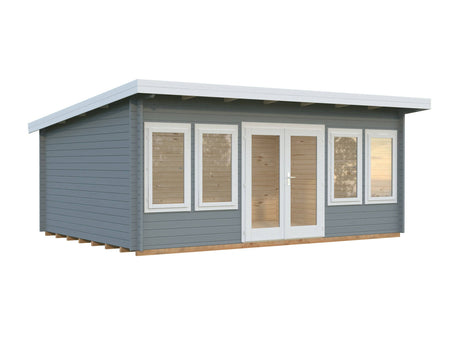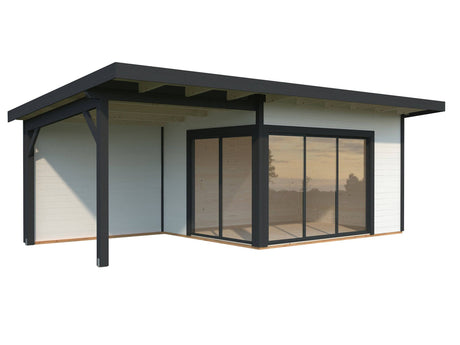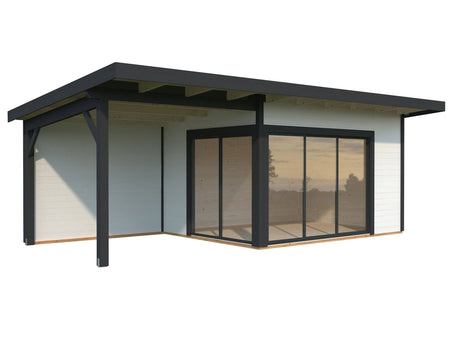Some of the UK had 30+ degree temperatures this September, so you might think a post about garden shed maintenance advice is badly timed, but the first Christmas puddings also arrived on supermarket shelves this month. This, and the ever shortening days, is always a depressing signal that autumn is really upon us.
Whilst it may be fine to leave the Christmas food and present shopping until late December, protecting your garden shed from autumn and winter gales won’t wait that long.
The rain, wind and damp of a British autumn are the three great enemies of any timber garden building. If you want to get maximum enjoyment and longevity from a garden shed, summer house or garden office, you need to keep them at bay. Here’s our garden shed maintenance advice broken into 10 handy tips that you should consider this autumn.
Tip number 1: Ensure nothing is left touching the building
Cut back any trees and shrubs near your timber garden buildings, as they will prevent air flow, and make it harder for timber to dry out between rain showers. Even worse, overhanging branches can easily damage the roof felt or shingles in high winds. It might be tempting to leave garden furniture, tools or logs resting against the back wall of the building where they are out of sight, but you need to leave a clear gap to stop moisture building up.
Tip number 2: Use the best garden shed timber treatment and preserver

All exposed wood should be treated with good quality wood preservative to prepare it for winter. Ideally, you will have done this when you first installed the building, but you also need to reapply regularly. Palmako recommend Barrettine wood preserver to stop wood boring insects, rot and fungal infection, plus Barrettine log cabin oil to help form a watertight layer. Cuprinol also has a good range of wood preservatives and protectors, as well as some good advice on how to protect and revive a shed.
And if you want to makeover your garden shed more radically, there are excellent stains and paints for timber buildings available in the Sadolin and Sikkens ranges.
If chemical infused preservatives or solvent based treatments aren’t for you, we also covered some environmentally friendly options for wood stain in an earlier blog post.
Tip number 3: Check the roof of your shed

If you have loose shingles, felt or flashing, their chances of surviving high winds are dicey. Far better to make small repairs before the first gales of winter strike than to have to deal with far bigger emergency roof repairs and water damage post-storms. You can buy replacement felt and shingles at most large DIY chains, and if you want to re-roof a Palmako building get in touch with us and we can quote for the appropriate amount of felt or shingles.
Tip number 4: Get out the oil can
Check that hinges, handles, locks and padlocks are moving freely, and give them a coat of oil to keep it that way. If you need to get oil inside locks or handles get a spray can of WD-40 with a straw – you can then spray right inside moving parts without having to take things apart. Also check that doors or windows open and shut easily; if they don’t, you’ll need to investigate further to check that frames haven’t swollen, warped or twisted. If you need to sand or plane a surface down to free a sticking door or window, remember to reapply wood preserver and treatment afterwards.
Tip number 5: Clear all gutters

If your shed or garden building has gutters, check they’re not blocked. Clear away all leaves and other blockages, and keep on doing this throughout the autumn. If gutters block, water may overflow down timber walls, causing damp problems. Should your garden building, whether a larger structure or a small shed be located underneath a large tree, leaf build-up could be a persistent problem. In this instance you might want to consider adding a mesh leaf trap guard to the top of your downpipe. This will allow water to flow through, but will stop leaf litter blocking the downpipe.
If your building doesn’t have gutters, look out for problems with water building up on roofs or running down the walls. It may be that adding gutters could prevent the problem escalating into more serious water damage. If you don’t like the look of gutters you could consider rain chains as much more interesting solution instead.
Tip number 6: Get rid of some junk
Freeing up some space in your summerhouse or workshop won’t in itself prolong its life. But a good tidy-up and clear-out may help you spot damp, watermarks, mould, nests or other problems.
In particular, have a rigorous inspection of the interior next time it rains, searching for any new leaks or damp problems that need treatment.
Tip number 7: Look out for the windows
Internal timber window frames and sills can sometimes develop damp problems caused by condensation, especially outside the summer months. Applying a quick coat of clear wood treatment to internal sills and frames can head off these problems. If the sills or frames are already damp, you’ll need to dry them out first.
Tip number 8: Clean surrounding decking and paving

Throughout the autumn, clear away leaves from your decking, including from any gaps. They can cause discolouration and perhaps damp too. When damp and covered in algae decking and paving can be like an ice rink. A good clean with a fungicidal decking cleaner and reviver will help remove algae, moss and mould from decking and paving. You may also need to reapply decking stain or treatment once the timber has dried. There’s some good advice on the B&Q website.
Tip number 9: Check out your shed base
Grass and leaves around the foot of a timber building can reduce air flow around and under the building, and prevent wooden walls or foundation joists from fully drying out. This makes the building more vulnerable to problems with damp, even where you have pressure-treated timber.
Tip number 10: Hunt down your spirit level and try square
While you’re on a maintenance session, you may also want to ensure that walls, door frames and windows are still at 90 degrees to the ground. If not, you may be suffering problems with subsidence or damp. Your heart will sink at having to work out how to solve the problem, but better to do so now than when further damage has set in!
If you follow this garden shed maintenance advice early each autumn you should ensure that your shed or garden room remains in good condition and continues to provide you with many years of trouble free use (but if you do need a new one, we can always help!).


























































